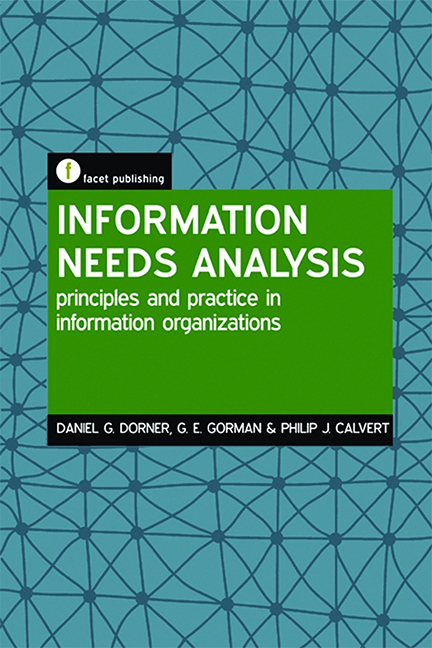Book contents
- Frontmatter
- Contents
- List of figures and tables
- List of scenarios
- About the authors
- Preface
- 1 Background to needs analysis for information managers
- 2 The importance of context in information needs analysis
- 3 Models and types of information needs analysis
- 4 The stages of information needs analysis
- 5 Gathering data for information needs analyses
- 6 Gathering data from existing sources
- 7 Gathering data through surveys
- 8 Gathering data through interviews
- 9 Analysing and integrating information needs analysis data
- 10 Reporting on an information needs analysis
- Bibliography
- Index
5 - Gathering data for information needs analyses
Published online by Cambridge University Press: 10 September 2022
- Frontmatter
- Contents
- List of figures and tables
- List of scenarios
- About the authors
- Preface
- 1 Background to needs analysis for information managers
- 2 The importance of context in information needs analysis
- 3 Models and types of information needs analysis
- 4 The stages of information needs analysis
- 5 Gathering data for information needs analyses
- 6 Gathering data from existing sources
- 7 Gathering data through surveys
- 8 Gathering data through interviews
- 9 Analysing and integrating information needs analysis data
- 10 Reporting on an information needs analysis
- Bibliography
- Index
Summary
Introduction
The data-gathering stage is central to any INA project. As noted in Chapter 4, information gathering is the second of four stages in the INA process, and it has a recursive relationship with the delineation or planning stage – that is, decisions about the means by which the data will be gathered must be based on careful planning. The centrality of the data-gathering stage is further evident by its recursive relationship with the subsequent data analysis stage.
This chapter provides an overview of the main methods for gathering the data necessary to identify and understand information needs in different information management contexts. As is the case in any research project, the method(s) selected in an INA project will depend on a wide range of contextual variables. Accordingly, in this chapter we seek answers to a number of data-gathering questions, specifically:
♦ How is the choice of data collection method related to the purpose of the INA?
♦ What factors should be considered when choosing a data-gathering method?
♦ How will existing data be used?
♦ What are the advantages and disadvantages of surveys in needs analysis?
♦ What are the advantages and disadvantages of interviews in needs analysis?
♦ What are the advantages and disadvantages of focus groups in needs analysis?
♦ What other methods can be used?
How we have reached this juncture
In Chapter 1 we identified three general levels of needs from Witkin and Altschuld (1995):
♦ Level 1 (primary) – the needs of the service receivers
♦ Level 2 (secondary) – the needs of the service providers and policymakers
♦ Level 3 (tertiary) – the needs related to the resources or solutions.
In Chapter 2 we discussed the importance of context in INA. We stated that an INA is never context-free and that the better the investigator recognizes this feature, the more reliable data he or she will collect about the environment, and the more adequate will be the resulting analysis of information needs of specific groups within that environment.
In Chapter 3 we noted that the three general levels of needs provide a framework for contextualizing information needs. These levels allow us to establish whether the analysis involves gathering data from and/or about people who are inside (service users, providers and policymakers) or outside the system (non-users).
- Type
- Chapter
- Information
- Information Needs AnalysisPrinciples and Practice in Information Organizations, pp. 87 - 112Publisher: FacetPrint publication year: 2017



